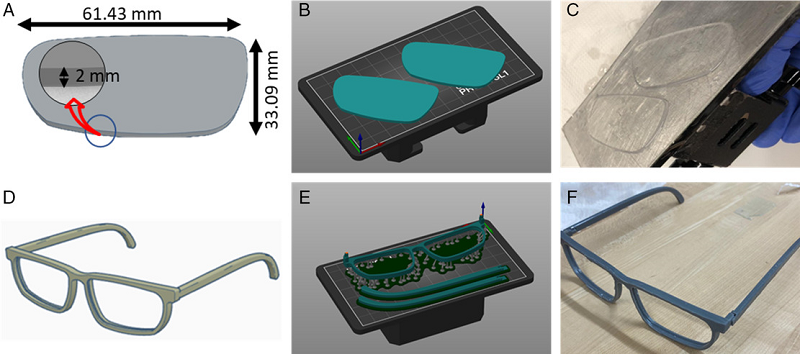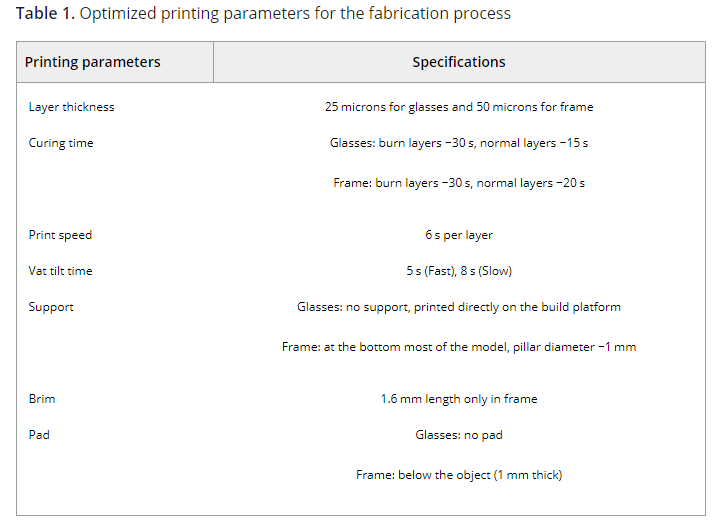Color vision deficiency (CVD), often known as color blindness, is an inherited ocular disorder that limits the ability of a person’s three retina cones (photoreceptors) to transmit the entire spectrum of colors, with the most common form being red-green color blindness. Wearing tinted glasses can often help people who are color blind correct their vision enough to deal with daily difficulties, but they’re not typically customized to fit individuals, meaning they’re often uncomfortable. A research team from Khalifa University of Science and Technology (KU) in Abu Dhabi hopes to turn this around by 3D printing customized lenses that provide the tinting effect.
The researchers used transparent resin mixed with two wavelength-filtering dyes to tint their 3D printed lenses. To make them similar to commercially available lenses, one dye blocks undesired wavelengths for red-green patients, while the other dye filters unwanted ones for yellow-blue patients. The team published their results in a research paper.

The 3D printing of glasses. A) CAD model of the glasses, B) preparing G-code by slicing the model, and C) digital photographs of the glasses 3D printed on build plate. D) CAD model of the frame, E) preparing G-code by slicing the model, and F) digital photographs of the 3D printed frame.
“Till date, a CVD cure is not developed, and treatment courses, such as gene therapy, are yet to be applied on humans. Hence, patients opt for wearable visual aids such as tinted glasses/contact lenses, which achieve the latter by filtering out problematic wavelengths for blue–yellow (440–500 nm) and red–green (540–580 nm) CVD patients, thus, enabling them to distinguish between the colors. Herein, the development of 3D printed glasses for color blindness management is reported,” the abstract states.
My husband is color blind. People sometimes ask me to describe it, and the example I always give is a morning he asked me the color of his shirt. It was St. Patrick’s Day, and he wanted to wear green to work, so he held up a shirt in the closet and asked, “Is this green?” My response? “No babe, that’s purple.” Color blindness is not debilitating the same way that blindness is, but it can make day-to-day tasks, like picking the right color shirt, very tricky. It can also keep people from working in fields where color recognition is necessary.
While it’s certainly not a new idea to 3D print lenses—even tinted ones with dyes to correct color blindness—3D printing to manufacture customized color blindness-correction glasses is, and the research team’s work could eventually offer color blind people a more comfortable option to distinguish between certain shades and colors.
Dr. Haider Butt, Associate Professor of Mechanical Engineering, said, “Patient-specific customization of glasses for CVD remains a challenge, even though research has significantly advanced the properties and materials of CVD wearables available on the market.”

Representation of image perceived by color vision deficient individuals. A) Photographs of colorful material seen by normal vision individual and different color vision–deficient individuals B) protanomaly, C) deuteranomaly, and D) tritanomaly, photographs converted from a colorblindness simulator website.(36) The activation of the photoreceptor cells at 520 nm for E) normal, F) deutan, G) protan, and H) tritan. Adapted from ref. (37) Copyright 2020, Wiley.
The researchers mixed two different dyes into the transparent resin to print their lenses, one to block the unwanted wavelengths for red-green patients, and another for yellow-blue patients, and printed them on an MSLA Prusa SL1 system in 0.5%, 1%, and 1.5% concentrations. Volunteers for these two types of CVD tested the lenses and found them to be beneficial, both in terms of comfort and vision improvement, when compared to commercially available CVD correction lenses. The KU team also used SOLIDWORKS and 3D printing to optimize the frames, to make them as close as possible to regular glasses.
“Our results showed that 3D printing had no influence on the wavelength-filtering properties of the dyes. In fact, the dyes remained unchanged as they were integrated with the resin and 3D printed,” Dr. Butt said. “When we compared the optical performance of our glasses with commercial glasses for colour blindness, our results indicated that our 3D-printed glasses were more selective in filtering undesired wavelengths than the commercially available options. They have great potential in treating colour blindness, and their ease of fabrication and customization means they can be tailored to suit each individual patient.”
Previous research on management and correction methods for CVD has revealed that leaching and toxicity problems can happen when using dyes. The KU team took precautions to ensure this didn’t happen, by examining the stability of their dyes first. The 3D printed glasses were stored in water for over a week, and no dye leaked into the water during this time, which means that the glasses are stable and safe for long-term use. Another test consisted of leaving the glasses open in ambient conditions for an additional week, and again they proved their stability, as well as flexibility and strength. The glasses were also found to have excellent durability, as the researchers found when they subjected them to bending and folding.
“The aforementioned findings show that these 3D-printed tinted glasses have great potential in combating colorblindness, owing to their ease of fabrication and customization, which can be tailored to the patient’s need,” the researchers concluded.
Subscribe to Our Email Newsletter
Stay up-to-date on all the latest news from the 3D printing industry and receive information and offers from third party vendors.
Print Services
Upload your 3D Models and get them printed quickly and efficiently.
You May Also Like
Colorado School of Mines’ First Satellite Campus is Part of ASTRO’s AM Hub in Guam
As I posted about last month, the Guam Additive Materials and Manufacturing Accelerator (GAMMA), a joint project of the Applied Science and Technology Organization (ASTRO) America and the Government of...
3D Printing News Briefs, November 29, 2025: Submarine Industrial Base, Running Shoe, & More
In this weekend’s 3D Printing News Briefs, we’ve got more news from Dyndrite, which has launched the NXG Slice Viewer for Nikon SLM Solutions. Farsoon Europe has news to share...
Formnext 2025: New Metal PBF 3D Printer, Serial Production Applications, & More
It’s Day 2 of Formnext 2025, where over 800 exhibitors from around the world have converged in Frankfurt for Europe’s premier additive manufacturing (AM) trade show. From exciting new printers...
Aibuild and Reichenbacher Hamuel Ink Partnership
Aibuild will partner with Reichenbacher Hamuel to bring to market multi-axis CNC hybrid tools with AI toolpathing. Aibuild is well known, of course, as a 3D printing software firm that connects...

































